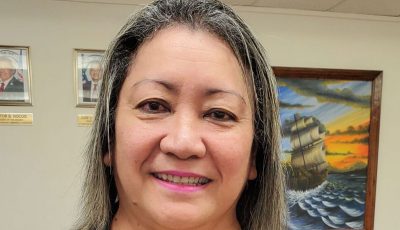Scientific conference ongoing at AMP Visitors Center
The Asia Pacific Academy of Sciences, Science Education, and Environmental Management is hosting a four-day conference, from Nov. 14 to Nov. 17, at the American Memorial Park Visitors Center auditorium, to update the public on the results of local scientific research.
On Monday, Nov. 14, the conference featured Judith R. Amesbury, whose topic, “Who Wears the Beads? 2,000 Years of Ornaments from an Archaeological Site on Guam,” focused on an archaeological excavation on one of the oldest sites in the Mariana archipelago, Chalan Piao, in 1989 that was conducted by Micronesian Archaeological Research Services archaeologists. There the MARS archaeologists found more than 400 cone shell beads and fragments of cone shell bracelets. No human remains were found, so the archaeologists could not say who would have worn those ornaments. Now an excavation has taken place in Guam, where more than 1,500 shell and shark teeth ornaments were found on the human burials. This presentation will answer the question, “Who wears the beads?”
Hadre Rogers, Ph.D. of the Iowa State University gave an update on the “Ecology of Bird Loss Program” while Kloe Borja talked about “Avian Gut Passage Time & its Role in Seed Dispersal.’”
Yvette Haughney and Susan Odonohue’s topic “Institute for Bird Populations: TMAPS Program and its History with Saipan” is intended to focus on the success and vitality rates of Saipan’s common birds so that the island has a baseline that will help scientists understand the health of Saipan’s native forests.
Yesterday, Gary Denton, Ph.D. talked about “Mercury Hotspots in the Saipan Lagoon.” Fish are excellent indicators of mercury pollution and, in contaminated waters, can accumulate levels sufficient to render them unfit for human consumption. In this study, they examined mercury levels in emperor fish (Lethrinus harak and L. atkinsoni) from 13 sites along the entire length of the Saipan lagoon.
Tara Tudela’s talk was titled “Surveillance of the Biological Control Establishment on Chromolaena odorat (Siam weed) on Saipan.”
Phillippe Lacson and Roy Adsit talked about “Sea Grass Resilience Assessment.” Seagrass meadows play an important role. Not only are they home to many aquatic organisms, they are also a main source of food and can hold down sediments, reducing coastal erosion and turbidity.
Carly Thissen of the Brigham Young University, Hawaii, talked about “Classifying Juvenile Sea Urchins Based on Possible Parent Species using DNA Barcoding.”
Today, Wednesday, Nov. 16, Michael Trianni will discuss “Survey of Juvenile Humphead wrasse in the Saipan lagoon.” A survey for juvenile humphead wrasse in Saipan lagoon was commenced during the summer of 2016. This presentation provides background information on the humphead wrasse, a summary of past research on the species in the CNMI, and preliminary findings from the current survey.
Trey Dunn and the CNMI Division of Fish and Wildlife will focus on “The Life History of a Species of Fish of the Holocentridae Family.”
Steve McKagan’s topic is “The Rota Creel Pilot Project: Fishing Participation and Interview Data in the Year of Storms, 2015.” The project marks the first attempt to systematically survey the shore-based fishing effort on Rota. The project was co-managed by CNMI DFW Fisheries Data Section, Micronesian Environmental Services and NOAA’s Habitat Conservation Division. .
John Gourley and the Micronesian Environmental Services will give “An Update on the Saipan Coral Reef Fish Biosampling Program.”
On the fourth day, Nov. 17, Dana Okano, Ph.D., and Ryan Okano, Ph.D. will focus on “Impacts of Groundwater on Nearshore Benthic Community Health.” Water quality is known to influence nearshore benthic communities. Much attention is focused on surface water quality, whether point source discharges or nonpoint source runoff. A recent study of nearshore sites throughout Saipan lagoon found groundwater quality to also impact nearshore benthic communities in the lagoon. This study looks at groundwater, nutrients, and benthic community health to assess influences on the lagoon community.
Maria Theresa D. Dizon will discuss “Comparing Antioxidant Capacity of Laboratory-prepared and Commercial Morinda citrifolia (Noni) Juices.” Noni products gained worldwide popularity since 2003 when the European Commission approved it as a “super/novel food”. Noni is traditionally used to various ailments and been scientifically demonstrated to improve type 2 diabetes (T2D), hyperlipidemia or cancer in mice, and has shown some health benefits in human studies.
Malia Scoville’s topic is “Methods to Enhance the Germination Rate of Heteropogon contortus.” Heteropogon contortus (Pili grass) is a perennial bunch grass indigenous to Hawaii that is useful in xeric landscaping for water conservation, in roadside plantings, and for re-vegetation and stabilization of eroded. However, due to the length of seed dormancy H. contortus can be difficult to germinate from seed.
Mark Lander, Ph.D. will talk about “Saipan’s Climate and Climate Change Comments Regarding the 2015/16 El Nino and Typhoon Soudelor” while Shahram Khosrowpanah, P.E., Ph.D., and interim dean at the School of Engineering, University of Guam, will discuss “UOG’s Emerging School of Engineering: Training Tomorrow’s Engineers to Meet Today’s Community Needs.” (APASEEM)



























